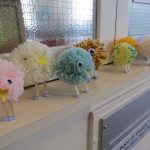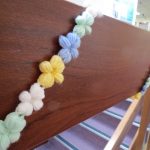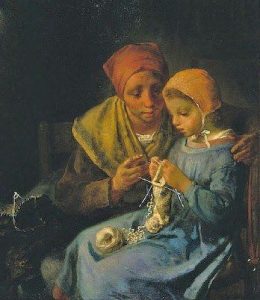We’ve worked hard this term to create a yarn bomb that builds on last term’s theme but is also different. Unsurprisingly, we chose Spring and have been knitting and crocheting flowers, butterflies, garlands and squares. A late arrival to the theme were pom pom chicks who are currently standing guard over the main office.
A very big part of the project is the construction. We walked around with various items trying them out, finding the very best place to fit them in. The teamwork required to install a yarn bomb relies on a keen eye or two, the power of discernment but also, more imporantly a true spirit of adventure. It may be that you are wondering where this spirit finds its outlet but if you’ve ever stepped from chair to chair, trying to find the exact spot where that carefully crocheted butterfly will hand, you’ll know what I mean.
It’s one of the real pleasures of installing a yarn bomb to witness other people’s reactions. I’ve spotted a number of staff and students taking photos, stroking the wool and gently repositioning the odd leaning chick. Because we have hung butterflies and flowers on the ceiling people are looking up and reaching to touch them. A yarn bomb is definitely a hands on experience, from its very beginnings to the finished ‘bomb’.








 ten, I look around at us all knitting and crocheting in the common room and am reminded of how many artists have chosen the knitter as inspiration. Is it the tranquility of features absorbed in the task? Is it something about the posture of the knitter, the bent neck, the symmetry of hands at work? Is it perhaps the contrast between sitter and their environment? For us, it is all of these things and a great deal more.
ten, I look around at us all knitting and crocheting in the common room and am reminded of how many artists have chosen the knitter as inspiration. Is it the tranquility of features absorbed in the task? Is it something about the posture of the knitter, the bent neck, the symmetry of hands at work? Is it perhaps the contrast between sitter and their environment? For us, it is all of these things and a great deal more.